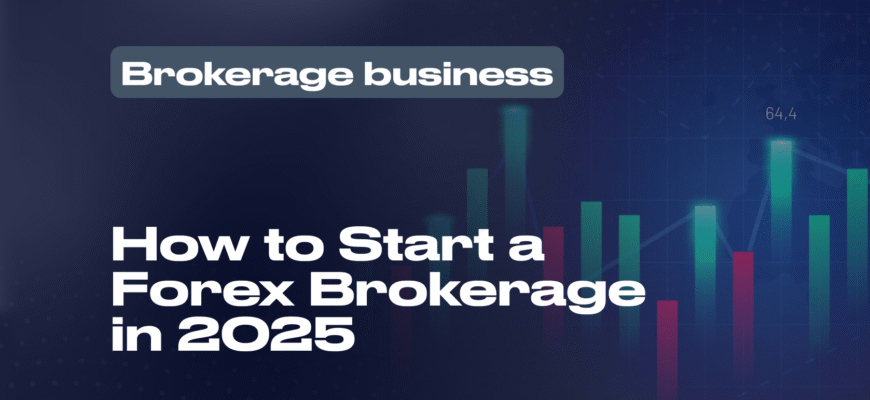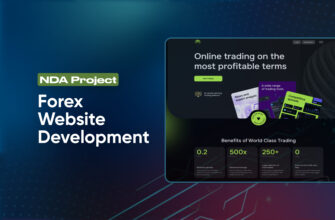- Conduct Deep Market Research
- Define Your Target Audience
- Select the Right Regional Focus
- Evaluate Competitors and Identify Gaps
- Understand Platform Preferences
- Why Market Research Matters
- Company Incorporation
- Banking and Payment Infrastructure
- Apply for a Forex License (or Start Unregulated)
- Compliance ReadinessModern brokerages must operate within strict regulatory frameworks.
- Define Your Revenue Model
- Align Your Model with Your Strategy
- Choose Your Technology Stack — Trading Platform, CRM & Back Office
- Find the Right Trading Platform
- Implement a Forex CRM System
- Build Your Website and Client Area
- Website Essentials
- Client Area (Trader’s Portal)
- Launch and Market Your Brokerage
- Ready to Launch Your Forex Broker?
Launching a forex brokerage in 2025 means stepping into a fast-moving, tech-driven market shaped by automation, global liquidity, and evolving trader expectations. With daily trading volumes exceeding $7 trillion, forex remains one of the most active sectors in modern finance — attracting both institutional players and a growing wave of retail clients worldwide.
Whether you choose a regulated or unregulated path, success hinges on making the right choices at each stage: selecting a suitable legal structure, obtaining a forex license (if needed), integrating reliable liquidity providers, deploying advanced forex broker software and CRM systems, and implementing a strong go-to-market strategy.
Fortunately, modern white label forex solutions make it easier than ever to enter the market quickly and cost-effectively—providing everything from platform technology to regulatory guidance.
In this guide, you’ll find a complete, step-by-step breakdown of how to start your own forex brokerage in 2025.
Conduct Deep Market Research
Solid market research is the starting point for any successful forex brokerage. Before choosing a jurisdiction, setting up legal structures, or investing in technology, you need a clear picture of your ideal client, regional demand, and competitive environment.
Define Your Target Audience
Determine which client segment your brokerage will serve:
- Retail traders – Individuals looking for user-friendly platforms, low entry barriers, mobile access, and educational content.
- Professional and institutional clients – Hedge funds, trading desks, or asset managers who demand deep liquidity, API access, high-speed execution, and custom integrations.
Your audience will influence everything from platform selection to customer support and marketing tone.
Select the Right Regional Focus
Choosing the right geographic market is vital to shaping your offering and ensuring compliance. Consider:
- Asia-Pacific & MENA – Fast-growing adoption of online trading platforms.
- Latin America & Africa – Mobile-first user base with rising interest in forex.
- Eastern Europe & CIS – Established retail trading culture with a need for localized platforms and multilingual support.
Evaluate regional regulatory requirements, preferred payment methods, device usage trends, and internet infrastructure.
Evaluate Competitors and Identify Gaps
A deep dive into your competitors reveals what’s already working and where gaps exist:
- Which platforms are they using?
- How are they pricing spreads, commissions, or fees?
- What is their marketing and onboarding strategy?
- Are there underserved niches or pain points (e.g., poor UX, lack of education, slow support)?
This insight allows you to position your brokerage uniquely in the market.
Understand Platform Preferences
Different client types and regions have different expectations. At minimum, your trading solution should support:
- Web and mobile trading
- Real-time data and fast execution
- Risk management and analytics tools
- Easy onboarding and funding features
Your choice between building a proprietary platform or using a white label forex solution will depend on both your technical capacity and your users’ needs.
Why Market Research Matters
Investing time in research helps you:
- Build a product that fits real demand
- Choose markets with strong ROI potential and manageable compliance
- Avoid costly missteps in design, marketing, or regulation
In 2025’s competitive forex environment, strategic insight is not a luxury — it’s your competitive advantage.
Company Incorporation
Your company’s legal foundation influences every part of your business—from taxes and compliance to banking and licensing.
Typical Legal Structures:
- LLC or IBC: Ideal for cost-effective setup in offshore jurisdictions.
- PLC or Ltd: Often required in regulated jurisdictions for transparency and governance.
Consult with legal experts to align your structure with your licensing and banking goals.
Banking and Payment Infrastructure
To manage both company operations and client funds, you must:
- Open corporate and segregated bank accounts
• Partner with reliable PSPs to accept credit cards, wire transfers, crypto, and digital wallets
• Ensure support for multi-currency operations, especially if targeting international markets
Choose partners familiar with FX businesses. Delays or account freezes are common with inexperienced institutions. A strong financial backbone inspires trust and supports smooth day-to-day operations.
Apply for a Forex License (or Start Unregulated)
Your next decision is whether to operate under a forex license in 2025 or remain unregulated initially.
Regulatory Jurisdictions for Forex Brokers:
| Region | Regulator | Approx. Timeline | Cost |
| Seychelles | FSA | 3–5 months | $15,000–$25,000 |
| Labuan (Malaysia) | LFSA | 4–6 months | $30,000–$40,000 |
| Mauritius | FSC | 6–9 months | $25,000–$35,000 |
| Cyprus | CySEC | 12–18 months | $100,000+ |
| UK | FCA | 12–24 months | $150,000+ |
| Unregulated | — | 1–2 weeks | <$5,000 |
Tip: Many startups begin with a soft launch using white label forex solutions in offshore jurisdictions, then pursue full regulation as they scale.
Compliance ReadinessModern brokerages must operate within strict regulatory frameworks.
Implement:
- AML/KYC procedures that meet global standards
- Internal transaction monitoring systems to flag unusual behavior
- Secure document verification flows (often automated or API-based)
Working with legal advisors or compliance consultants at this stage will prevent costly mistakes later.
Define Your Revenue Model
Once you’ve chosen your brokerage structure, it’s time to define how your company will make money. Typical options include:
- Spread-Based Revenue
You earn revenue from the difference between bid and ask prices. This is common for Market Makers and sometimes STP brokers, depending on how pricing is structured.
- Commission-Based Revenue
Clients pay a fixed fee or percentage per trade, typically on both sides (entry and exit). This model is widely used in ECN and STP environments, where spreads are kept low and pricing is transparent.
- Spread Markups
In this hybrid model, you add a markup to the prices provided by your liquidity partners, creating an additional layer of profit without direct commissions.
Align Your Model with Your Strategy
Your ideal model depends on three key factors:
- Risk appetite — are you comfortable with market exposure, or do you want a flow-through model?
- Target audience — retail vs. institutional clients may prefer different pricing and execution styles.
- Technical and operational resources — ECN setups require robust infrastructure and integration, while Market Makers need strong risk controls.
Choose Your Technology Stack — Trading Platform, CRM & Back Office
Technology is the engine of any forex brokerage. To succeed in 2025, your setup must be fast, secure, and intuitive — both for traders and your internal team. Whether you’re launching independently or using white label forex solutions, assembling the right tools is critical from day one.
Find the Right Trading Platform
Your trading platform is the front line of your business. It must deliver speed, stability, and a seamless user experience across devices.
There are several routes to consider:
- Established third-party solutions — Widely used platforms that offer proven infrastructure and broad compatibility with market tools.
- Modern alternatives — More recent platforms that focus on enhanced transparency, customizable UI, and advanced analytics.
- Proprietary or custom-built systems — Tailored platforms designed for specific business models, often used to differentiate the brand or support unique workflows.
Implement a Forex CRM System
A forex CRM ties your brokerage together — connecting sales, support, onboarding, and marketing into a single dashboard. This is essential for scaling operations and managing relationships effectively.
Key CRM features to look for:
- Lead capture and pipeline tracking
- Automated KYC document management
- IB and affiliate tracking
- Multilingual support ticket system
- Integrated email and remarketing tools
Advanced forex CRMs can sync directly with your trading platform and back office to provide real-time insights and smooth user journeys.
Build Your Website and Client Area
Your website and trader dashboard are the digital face of your brand. Make them fast, secure, and easy to use.
Website Essentials
Your website should:
- Load quickly and be mobile-friendly
- Follow modern design standards
- Include SSL encryption, GDPR compliance, and legal disclaimers
- Showcase licenses, certificates, and partnerships
Client Area (Trader’s Portal)
This is where users interact with your service. It should offer:
- Account creation, identity verification (KYC), and onboarding
- Deposit/withdrawal functions with multiple payment options
- Platform access/downloads
- Trade and transaction history
Launch and Market Your Brokerage
Now comes the exciting part—going live. You may have the best tech, but without traders, your business won’t survive. A strong acquisition strategy is critical.
Key Launch Activities:
- Beta testing your systems with demo and live accounts
- Finalizing branding: logos, domains, compliance pages
- Building your website with SEO landing pages
- Social proof: Collect testimonials or feedback from early adopters
Marketing Strategy:
- Paid ads (Google, Meta, YouTube)
- SEO blog content and landing pages
- Influencer partnerships
- Email campaigns and remarketing
- Affiliate and IB networks
Don’t use a one-size-fits-all approach. Adapt your messaging, visuals, and tone to match the culture, language, and regulations of your target regions.
Ready to Launch Your Forex Broker?
Starting a forex brokerage in 2025 is more than just setting up a platform or choosing a license — it’s about building a scalable, compliant, and competitive business in a fast-moving global market. Success depends on how well you align your technology, operations, marketing, and regulatory strategy from day one.
Whether you’re planning to launch a niche brand, enter a high-volume segment, or explore new markets, working with experienced partners can save you time, reduce risk, and set you up for long-term growth.
Need Expert Support?
We help entrepreneurs and fintech teams bring their brokerage ideas to life — from concept to launch and beyond.
- Turnkey white label forex solutions
- Custom platform integration and liquidity setup
- Regulatory consulting and licensing guidance
- CRM and back-office infrastructure
- Post-launch growth support and scaling strategies
Let’s build something powerful together.
Contact us today to discuss your project and explore tailored setup options.





